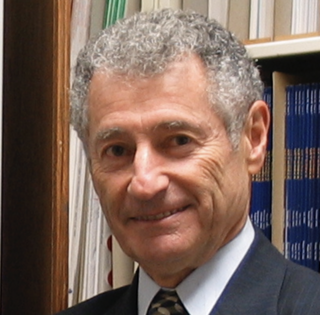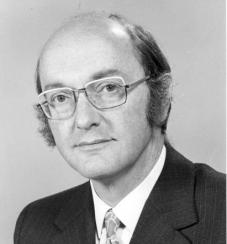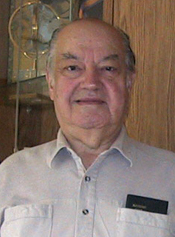Howard Frank | |
|---|---|
| Born | June 4, 1941 |
| Died | May 1, 2017 (aged 75) |
| Citizenship | US |
| Alma mater | PhD 1965 University of California, Berkeley |
| Known for | ARPANET |
| Awards | Presidential Distinguished Service Medal, Internet Hall of Fame |
| Scientific career | |
| Fields | Electrical engineering, computer science |
| Institutions | UC Berkeley, Office of Emergency Preparedness, Network Analysis Corporation |
| Thesis | Optimum Locations on a Graph with Probabilistic Demands [1] (1965) |
Howard Frank is a network engineer who laid the groundwork for analyzing and designing computer networks. [2]
Howard Frank was an academic from 1965, the year he finished his PhD, to 1968 before working for the OEP as a consultant. He then went on to found the Network Analysis Corporation a year later along with a business associate. After selling NAC to Contel Corporation, he created Network Management Incorporated in 1986. He left his corporate career in 1990 to work at DARPA where he was the founding director of Defense Department's Advanced Information Technology Services Joint Program. In 1997 he was appointed as dean of Robert H. Smith School of Business, University of Maryland, College Park where he worked until he retired in 2015. [3] [4]
His thesis: "Optimum Locations on a Graph with Probabilistic Demands" [1] which he described as "built on probabilistic graphs of some applications and it was statistical communication type theory, sort of an extension of the Von Neumann work" [3] was completed in 1965. Dr Frank was hired as assistant professor of engineering and computer science at the university in which he completed his PhD, that is University of California, Berkeley. During his work there he met Leonard Kleinrock and would later work with him at the OEP.
While writing his PhD, Howard Frank stumbled on a paper published in the Journal of Mathematical Biophysics on how cells reacted to radiation. He noticed that the mathematical model developed in that research could be applied to work done by Paul Baran in a series of papers called "On Distributed Communication". [5] This insight allowed for the operations detailed in Paul Baran's work to be cut down significantly from the thousands of hours of simulation time originally necessary. Howard Frank explained in one of his interview how this kind of insight perfectly displays his talent: "My talent is that I'm a synthesist. I'm not an original creator of advanced mathematics. Never have been, but as a synthesist, I can take ideas from different fields and put them together, and I could create new things out of that, and because of that, nobody else was working in the field, I was cream skimming. I could say: "What about this?" And nobody would have thought about it yet. Nobody would have worked on it, so I worked on it." [3]
After being noticed by a White House official at a talk on his breakthrough on Paul Baran's work, Howard Frank was invited to work at the Office of Emergency Preparedness as a consultant. The project he worked on was a proof of concept that an Office of Analytic Planning could have its use in the White House. The group he worked in therefore had to "Find a problem and solve it." [3] They tackled two problems. The first one on how to design offshore natural gas pipeline networks for the Federal Power Commission in the Gulf of Mexico, that is, finding a system and an analytical approach to design pipelines therefore helping the Federal Power Commission review new pipeline projects. The second one on network vulnerability and survivability, survivability of the country's assets in the event of a war. The group of no more than 20 people solved the pipeline question in 11-month by making a computer program which could optimize the pipeline network to lower costs therefore saving hundreds of millions of dollars. [6]
After finishing his project at the OEP, in 1969, Howard Frank and Dave Rosenbaum created the Network Analysis Corporation in an effort to solve similar issues than the ones encountered while working at the OEP. Dr Frank was contacted by Lawrence Roberts to work on the topological design of the ARPANET. The NAC, with Howard as its principal investigator on this project, worked on building models with the Control Data 6600 to analyze the network and find ways to optimize it. They analyzed the network and designed upcoming changes and expansions of the network. The NAC also modeled the economics of packet switching on data and voice in a bid to convince companies to adopt this new technology. Howard attended one meeting where he and Lawrence Roberts displayed the advantages of packet switching to AT&T in telephone networks to no avail. [3] [6]
The NAC also worked with DARPA on a network based on the ARPANET for military use. The analysis they ran and designs they submitted led to the creation of the project AUTODIN II which never was realized. It was instead replaced by the Defense Data Network which instead of being separated from ARPANET like AUTODIN, used ARPANET. The Defense Data Network relied on the work done by the NAC for AUTODIN II.
Howard Frank is married to Jane Frank. They had 3 children: David, Laura, and Erica. [4]
The Franks are also known for their impressively large Sci-Fi Art Collections. [7]

The history of the Internet has its origin in the efforts of scientists and engineers to build and interconnect computer networks. The Internet Protocol Suite, the set of rules used to communicate between networks and devices on the Internet, arose from research and development in the United States and involved international collaboration, particularly with researchers in the United Kingdom and France.

Stephen D. Crocker is an Internet pioneer. In 1969, he created the ARPA "Networking Working Group" and the Request for Comments series. He served as chair of the board of the Internet Corporation for Assigned Names and Numbers (ICANN) from 2011 through 2017.
A datagram is a basic transfer unit associated with a packet-switched network. Datagrams are typically structured in header and payload sections. Datagrams provide a connectionless communication service across a packet-switched network. The delivery, arrival time, and order of arrival of datagrams need not be guaranteed by the network.

In telecommunications, packet switching is a method of grouping data into packets that are transmitted over a digital network. Packets are made of a header and a payload. Data in the header is used by networking hardware to direct the packet to its destination, where the payload is extracted and used by an operating system, application software, or higher layer protocols. Packet switching is the primary basis for data communications in computer networks worldwide.
The end-to-end principle is a design framework in computer networking. In networks designed according to this principle, guaranteeing certain application-specific features, such as reliability and security, requires that they reside in the communicating end nodes of the network. Intermediary nodes, such as gateways and routers, that exist to establish the network, may implement these to improve efficiency but cannot guarantee end-to-end correctness.

The Advanced Research Projects Agency Network (ARPANET) was the first wide-area packet-switched network with distributed control and one of the first computer networks to implement the TCP/IP protocol suite. Both technologies became the technical foundation of the Internet. The ARPANET was established by the Advanced Research Projects Agency (ARPA) of the United States Department of Defense.

Robert Elliot Kahn is an American electrical engineer who, along with Vint Cerf, first proposed the Transmission Control Protocol (TCP) and the Internet Protocol (IP), the fundamental communication protocols at the heart of the Internet.

Leonard Kleinrock is an American computer scientist and Internet pioneer. He is a long-tenured professor at UCLA's Henry Samueli School of Engineering and Applied Science.

Donald Watts Davies, was a Welsh computer scientist who was employed at the UK National Physical Laboratory (NPL).
The domain name arpa is a top-level domain (TLD) in the Domain Name System (DNS) of the Internet. It is used predominantly for the management of technical network infrastructure. Prominent among such functions are the subdomains in-addr.arpa and ip6.arpa, which provide namespaces for reverse DNS lookup of IPv4 and IPv6 addresses, respectively.

Paul Baran was a Polish-American engineer who was a pioneer in the development of computer networks. He was one of the two independent inventors of packet switching, which is today the dominant basis for data communications in computer networks worldwide, and went on to start several companies and develop other technologies that are an essential part of modern digital communication.
The Automatic Digital Network System, known as AUTODIN, is a legacy data communications service in the United States Department of Defense. AUTODIN originally consisted of numerous AUTODIN Switching Centers (ASCs) located in the United States and in countries such as England and Japan.

The Interface Message Processor (IMP) was the packet switching node used to interconnect participant networks to the ARPANET from the late 1960s to 1989. It was the first generation of gateways, which are known today as routers. An IMP was a ruggedized Honeywell DDP-516 minicomputer with special-purpose interfaces and software. In later years the IMPs were made from the non-ruggedized Honeywell 316 which could handle two-thirds of the communication traffic at approximately one-half the cost. An IMP requires the connection to a host computer via a special bit-serial interface, defined in BBN Report 1822. The IMP software and the ARPA network communications protocol running on the IMPs was discussed in RFC 1, the first of a series of standardization documents published by what later became the Internet Engineering Task Force (IETF).

Lawrence Gilman Roberts was an American engineer who received the Draper Prize in 2001 "for the development of the Internet", and the Principe de Asturias Award in 2002.
Peter Thomas Kirstein was a British computer scientist who played a role in the creation of the Internet. He made the first internetworking connection on the ARPANET in 1973, by providing a link to British academic networks, and was instrumental in defining and implementing TCP/IP alongside Vint Cerf and Bob Kahn.

Pål Spilling was a Norwegian Internet pioneer and professor at the University of Oslo and the UNIK Graduate Center at Kjeller in Norway.
The Symposium on Operating Systems Principles (SOSP), organized by the Association for Computing Machinery (ACM), is one of the most prestigious single-track academic conferences on operating systems.

The NPL network, or NPL Data Communications Network, was a local area computer network operated by a team from the National Physical Laboratory (NPL) in London that pioneered the concept of packet switching.
A long-running debate in computer science known as the Protocol Wars occurred from the 1970s to the 1990s, when engineers, organizations and nations became polarized over the issue of which communication protocol would result in the best and most robust computer networks. This culminated in the Internet–OSI Standards War in the 1980s and early 1990s, which was ultimately "won" by the Internet protocol suite (TCP/IP) by the mid-1990s and has since resulted in most other protocols disappearing.